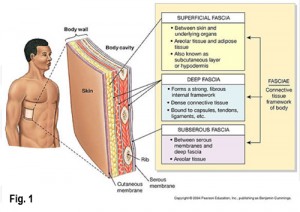Fascia is the soft-tissue component of the connective tissue system that permeates the human body. Thus, forming a continuous, whole-body, three-dimensional matrix of structural support. It interpenetrates and surrounds all organs, muscles, bones, and nerve fibers, creating a unique environment for body systems functioning (2,3).
Why is it important?
As one understands its vastness and integration through the body, it is easy to understand how dysfunction of this tissue can result in both local and referred disruptions to ones muscular and skeletal systems. This can present itself in various ways, but from my clinical experience I often see fascial dysfunctions common with chronic tendinopathy – examples being tennis/golfers elbow and bicep long head tendinopathy – chronic tension headaches, postural dysfunction, and pain/immobility from excessive scar tissue formation.
What Your Therapist Can Do For You.
Our goal as therapists – when dealing with fascial restrictions – is to aid in the deformation of cross links and adhesion that can form between fascial layers. These cross links can disrupt the natural slide and glide necessary for healthy muscles and movement. Therapists use manual forces – which can be applied as a lift, bow and/or shear – and are believed to tense the fasciae system, stimulating a progressive, large chain of reflexes, up to the point of tissue release (1). These holds are often applied for a couple minutes or longer, and can sometimes take multiple treatments to address; this is due to the slow adapting nature it possesses.
What Can You Do At Home?
First and foremost, make sure to listen to your therapist regarding any homecare that is given, this will help maximize the effects of your wonderful massage. Some other tips for being proactive for your fascia:
- Stay hydrated, the ground substance in fascia needs to maintain fluidity to help aid in the sliding and gliding of muscles.
- Stay moving, fascia has been shown to be responsive to slow and dynamic stretching, as well as proprioception refinement (4). Regular Tai Chi and Yoga can help address these, just do your research and don’t overdo anything, listen to your body!
- Foam rolling, take a class or check some videos on YouTube for some guidance. Again, don’t overdo anything and give yourself a day or two after your first session to adequately gauge your bodies response.
Luckily, leaders in this field like Dr. Carla Stecco, Dr. Tom Findley, and Dr. Robert Schleip are changing the way we look at fascia and its relation to the body, but more importantly are posing the questions to others to further the advancing knowledge of fascia.
Brock Anderson, RMT
References
- Bertolucci L, Kozasa E. (2010) Sustained Manual Loading of the Fascial System Can Evoke Tonic Reactions: Preliminary Results. International Journal of Therapeutic Massage and Bodywork. Volume 3, Number 1, March.
- Findley, T. (2010) Fascia Research 2012: Third International Fascia Research Congress. International Journal of Therapeutic Massage and Bodywork. Volume 3, Number 4, December.
- Findley, T. (2012) Fascia Research from a Clinician/Scientist’s Perspective. International Journal of Therapeutic Massage and Bodywork. Volume 4, Number 4, December.
- Schleip, R et al. (2013) Training principles for fascial connective tissues: Scientific foundation and suggested practical applications. Journal of Bodywork and Movement Therapies, Vol. 17, Issue 1, 103-115.




